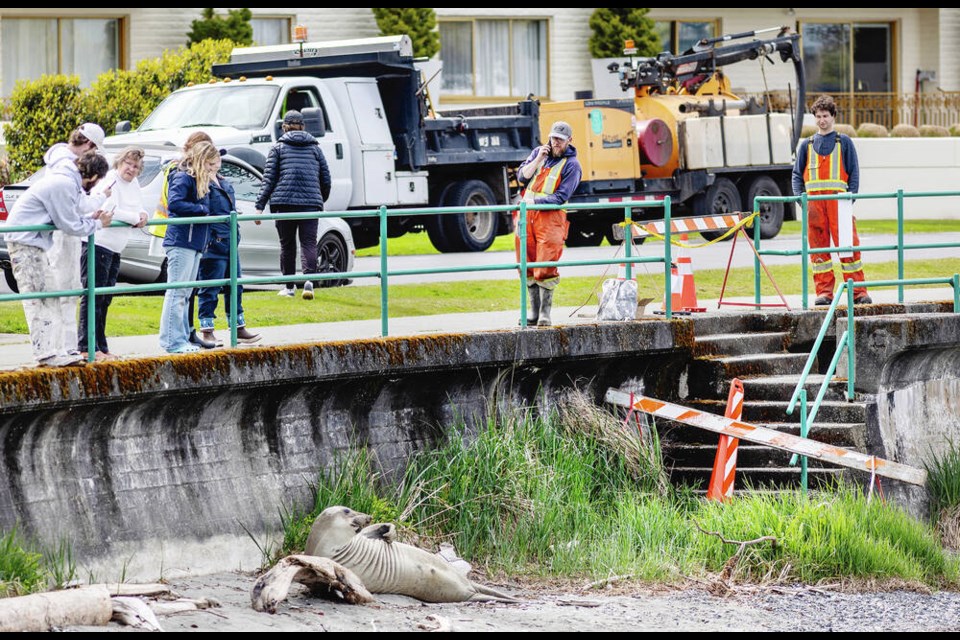Emerson the elephant seal should be going through the painful process of moulting on a remote beach.
But the celebrity seal for some reason is choosing to make his ordeal very public.
He’s been gawked at by school groups and tour buses, sniffed by dogs and the subject of selfies and media attention for weeks now around the capital region.
And now he needs some bodyguards.
A diverse team of volunteers co-ordinated by Fisheries and Oceans Canada has been following Emerson’s vagabond moulting ways for a few days now, making sure people stay off the beach or keep their distance and speak in hushed tones as the two-year-old northern elephant seal moults both hair and skin.
They’re working shifts daily wherever Emerson shows up.
Halle Bell, who works for the Shaw Centre for the Salish Sea, was taking a shift to watch over Emerson and educate onlookers on what the young elephant seal is going through Wednesday afternoon at Oak Bay Marina, his latest landing spot after spending a couple of days at McNeill Bay and then Kitty Islet in South Oak Bay.
Two hours into her shift, about 30 people had come by. She said Emerson “does OK if there are no dogs on the beach or people aren’t too loud … We’re just trying to make sure people keep their distance and be as quiet as possible,” said Bell.
Emerson does make it difficult for his watchers, however. He’s right up against the seawall near a stairwell along a busy public sidewalk wrapping around the marina.
Pat Rasmussen, 90, who lives across the street from the marina, looked out her window Wednesday morning to see Emerson lumbering ashore, the second time in as many years he’s decided to moult at the same spot.
“Some people have cats and dogs for pets … I have Emerson,” Rasmussen said as she snapped a few photos. “I just love him.”
The Sidney-based Shaw Centre, however, issued a plea on social media for people to stay away from Emerson while he’s going through what’s called a catastrophic moult, where elephant seals shed both hair and skin in a long, stressful and painful process that can take more than a month.
“When images of Emerson are posted it encourages others to go do the same,” the Shaw Centre said. “Emerson needs space, not fame. What seems innocent can have negative consequences.
“You may feel like just one person, but collectively it’s simply too many.”
The Shaw Centre's social media post said staff have witnessed “very concerning behaviour by people wanting to get close to this wild animal.”
It said a tour bus company was bringing people to McNeill Bay, making it “nearly impossible to maintain an environment that is suitable for Emerson’s welfare.”
The Department of Fisheries and Oceans has since spoken with the tour bus company, the Shaw Centre said in a statement on Wednesday.
Even as the stairwells to the beach and Kitty Islet — with its colourful lawn chairs — were taped off with warnings posted, people were hopping over or skirting the edges to see the elephant seal on Wednesday, said Joan Kline, who lives on Beach Drive near McNeill Bay.
Kline said one day, a boat with two adults come close to shore blaring loud music to look at the elephant seal.
“And that went on for some time,” said Kline, shaking her head.
The Shaw Centre said it’s critical that elephant seals have a quiet, restful place to undergo their moult, so onlookers and their pets should keep their distance and avoid doing anything that will disrupt their sleep and cause them to use energy unnecessarily.
Born in January 2022 in Bowman Bay in Puget Sound, the elephant seal gained a loyal following in the area when he spent about a month moulting at Oak Bay Marina beach last year, and made his way onto the boulevard next to Beach Drive.
Despite several efforts to relocate him, he continues to return to area waters.
After Emerson was spotted this month in the Gorge Waterway in Saanich, then hanging out at Gorge and Admirals roads in a bike lane, he was relocated April 5 to Barkley Sound near Ucluelet, but returned to Victoria’s Gonzales Beach only six days later.
It was the fifth time Emerson had been relocated by the Department of Fisheries and Oceans since his first appearance at Whiffin Spit near Sooke in May 2023.
Victoria Nelson, a volunteer with Seal Sitters, a Seattle-area group of volunteers who work with federal officials to protect marine mammals on beaches, said they are regularly posted to waterways to educate the public on moulting animals and young seal pups left on shorelines while their mothers feed.
Another member of the group, Diane Christman, gave the Shaw Centre “oceans of gratitude” for helping to educate Victoria’s public on Emerson.
“We have all been very concerned for [Emerson’s] well being,” said Christman. “We hope that the community there will rally together to protect him.”
Emerson’s mother hauled out in Puget Sound on April 1, the same day Emerson did here, Christman said: “We have been seal sitting for 23 days now, from sun up to sundown. It takes a lot of effort, but the rewards are so rich.”
In the U.S., the public is kept at least 100 yards from marine mammals on land — though it’s not always possible, said Nelson. Fines for harassment can reach $10,000.
Disturbing marine mammals under any circumstance is prohibited under Canada’s fisheries regulations. Fines can reach $100,000 and are regularly issued in the thousands and tens of thousands of dollars, the department said in a statement.
— with files from Michael John Lo




